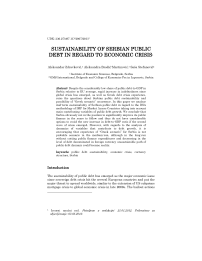Sustainability of Serbian Public Debt in regard to Economic Crisis
Автор: Aleksandar Zdravković, Aleksandra Bradić-Martinović, Saša Stefanović
Журнал: Ekonomski signali @esignali
Статья в выпуске: 1 vol.7, 2012 года.
Бесплатный доступ
Despite the considerably low share of public debt-to-GDP in Serbia relative to EU average, rapid increase in indebtedness since global crisis has emerged, as well as Greek debt crisis experience, raise the questions about Serbian public debt sustainability and possibility of “Greek scenario” occurrence. In this paper we analyze mid-term sustainability of Serbian public debt in regard to the DSA methodology of IMF for Market Access Countries taking into account main contributing variables of public debt growth. We conclude that Serbia obviously not in the position to significantly improve its public finance in the years to follow and thus do not have considerable options to avoid the new increase in debt-to-GDP ratio if the second wave of crisis emerged. However, with regards to the analysis of dynamics of variables that contribute to debt growth, it is encouraging that experience of “Greek scenario” for Serbia is not probable scenario in the medium-run, although in the long-run without cutting public finance expenditures and decreasing in the level of debt denominated in foreign currency unsustainable path of public debt dynamic could become reality.
Public debt sustainability, economic crisis, currency structure, Serbia
Короткий адрес: https://sciup.org/170204217
IDR: 170204217 | УДК: 336.27(497.11)"2007/2011"
Список литературы Sustainability of Serbian Public Debt in regard to Economic Crisis
- Akyüz, Y., Debt Sustainability in Emerging Markets: A Critical Appraisal. UN DESA Working Paper No. 61, 2007.
- Burnside, C., Assessing New Approaches to Fiscal Sustainability, World Bank Economic Policy and Debt Department, Washington, D.C, 2004.
- Debrun, X., Celasun O., Ostry, J. Primary surplus behavior and risks to fiscal sustainability in emerging market countries: a "fan-chart" approach. IMF Working Papers No. 06/67, 2006
- Fiscal Council, Proposal for Harmonizing Different Methodologies of Public Debt Coverage and Measurement in Serbia, //fiskalnisavet.rs/images/dokumenti/metodologija_javnog_duga.pdf/, 2012.
- Gray at al., A risk-based debt sustainability framework: incorporating balance sheets and uncertainty, IMF Working Paper No. 08/40, 2008.
- International Monetary Fund, Country Report No. 10/25, 2010.
- International Monetary Fund, Staff Guidance Note on Debt Sustainability Analysis for Market Access Countries. IMF Paper 2008.
- International Monetary Fund, Debt-related vulnerabilities and financial crises - an application of the balance sheet approach to emerging market countries, IMF Paper, 2004.
- International Monetary Fund, Debt sustainability in low-income countries - towards a forward-looking strategy, IMF Paper, 2003.
- Jemec at al., How do fiscal shocks affect the macroeconomic dynamics in the Slovenian economy?, National Bank of Slovenia Working Paper, 2011.
- Tran-Nguyen, A., Tola, A., The mechanics of debt sustainability analysis, Compendium on Debt Sustainability and Development, UNCTAD, 2009.
- Wyplosz, C., Debt Sustainability Assessment: Mission Impossible. Review of Economics and Institutions, Università di Perugia, Dipartimento Economia, Finanza e Statistica, vol. 2(3), 2011.
- Law on Public Debt, Official Gazette RS, 78/11 and 107/9.
- Law on Budget System, Official Gazette RS 54/09, 73/10 and 101/10.
- Ministry of Finance of the Republic of Serbia, www.mfin.gov.rs.
- National Bank of Serbia, www.nbs.rs.
- Serbian Statistical Office, www.stat.gov.rs.


